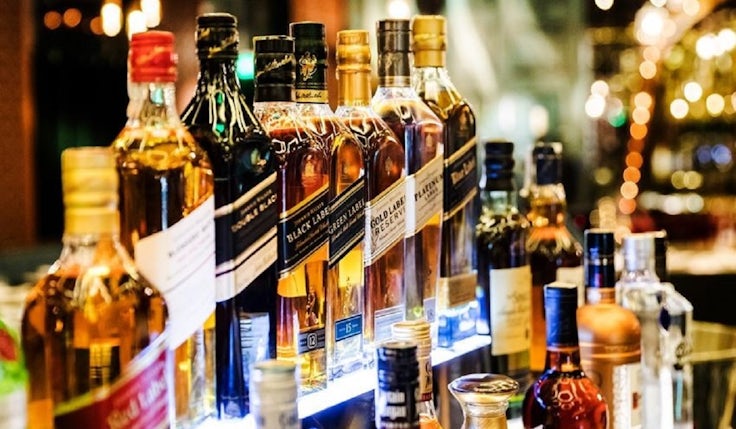Profit warnings, digital advertising, menopause: 5 interesting stats to start your week
We arm you with all the numbers you need to tackle the week ahead.
Number of UK companies issuing profit warnings up by 50%
The number of UK companies issuing warnings over profit rose by 50% to 305 last year, representing almost 18% of UK-listed companies.
Consumer facing businesses were the most likely to issue these warnings to investors, with more than one third in the sector doing so. Some 36 retailers and 25 travel and leisure companies issued profit warnings in 2022, according to analysis from EY-Parthenon.
Clothing brand Superdry became the latest listed business to issue a profit warning on Friday (27 January). It told investors it was likely to just break even this year, after its wholesale business has struggled post-pandemic.
Rising costs are the most common reason cited for businesses struggling when profit warnings were made. The last three months of the year saw the slowdown of the UK economy begin to kick in for businesses. In this period, one in five of those issuing profit warnings cited waning consumer confidence as a reason.
The number of companies to issue warnings in the second half of 2022 was 169, representing the highest total in this period since 2015.
While warnings were up 50% on 2021, they were down from 2020. In the year which saw the pandemic take hold, 35% of UK-listed companies issued warnings.
Source: EY-Pathenon
Europeans cut back on alcohol spending in 2022
 Alcohol retail sales declined by €2.7bn (£2.37bn) in 2022 in the largest European markets (UK, France, Germany, Italy, Spain and the Netherlands) as consumers cut back in an environment of rising prices and falling discretionary income.
Alcohol retail sales declined by €2.7bn (£2.37bn) in 2022 in the largest European markets (UK, France, Germany, Italy, Spain and the Netherlands) as consumers cut back in an environment of rising prices and falling discretionary income.
The pandemic saw a boost for retail alcohol sales, as consumers were confined to their homes. In 2020, alcohol sales by value increased by 12.6%. This added an extra €7.5bn (£6.59bn) to the off-trade market that year.
In 2021, sales effectively returned to normal, with the market growing a marginal €500m (£440m).
IRI predicts alcohol sales, both in the off-trade and on-trade, are unlikely to grow this year without investment in new products tailored to new consumer needs and consumption moments that make the category relevant again.
“Alcohol sales tend to peak during a recession as consumers eat in instead of out. However, this recession is fuelled by a perfect storm of exceptionally high food and energy prices, record interest rate rises and anaemic wage growth,” says global SVP, strategic growth insights Ananda Roy.
“Households are having to make trade-offs to moderate its impact on their available income, prioritising food staples and small indulgent treats over discretionary items like Alcohol. Alcohol sales are now lower than pre-pandemic levels.”
The research also found no and low-alcohol beverages were bucking the trend in 2022. These products now make up 1% of total beer, wine and spirits sales in Europe. The UK saw a 3.7% growth in volume sales for no and low-alcohol drinks.
Source: IRI
Digital now makes up more than three-quarters of ad spend share
 Digital advertising now accounts for 73.3% of total global ad spend, with its share of spend having risen rapidly since the pandemic.
Digital advertising now accounts for 73.3% of total global ad spend, with its share of spend having risen rapidly since the pandemic.
Back in 2019, digital advertising accounted for 57.4% of total global ad spend. By 2020 that proportion had risen to 64.4% and by 2021 it reached 70.1%.
In absolute terms, digital ad revenues have risen by 78% over the past three years, from a pre-pandemic total of just under $375bn (£303bn) in 2019, to more than $667bn (£538bn) in 2022.
An analysis of figures by We Are Social and Meltwater suggests companies spent a combined annual total of almost $880 (£710) per internet user to reach online audiences in the US in 2022. The analysis lists the UK as the country with the second highest spend, at $566 (£457) per user. At the other end of the scale, brands only invested a combined annual total of $5.26 (£4.25) per internet user to reach online audiences in India in 2022.
The research also finds internet users have reduced their time spent online post-pandemic. The average internet user globally has reduced their average daily internet use by 20 minutes over the past 12 months to six hours and 37 minutes, representing a year-on-year decline of almost 5%.
Source: We Are Social/Meltwater
Around nine in 10 midlife women wish brands were more inclusive to the menopause
 The overwhelming majority (90%) of menopausal women wish brands were more inclusive to the menopause.
The overwhelming majority (90%) of menopausal women wish brands were more inclusive to the menopause.
A similar proportion (91%) report never having seen advertising or marketing for menopause-related products. The research also finds that, despite a 94% increase in news coverage around the menopause since 2020, the proportion of women who say products are not easy to find in-store (55%) has not changed in two years.
However, some progress on the issue has been made over the past two years. Two in five menopausal women (40%) now say that some brands are accurately portraying and catering well to midlife and menopause, up from around a third (35%) who said the same in 2020. One fifth (20%) more menopausal women now describe midlife advertising as inspirational.
Source: GenM
Least affluent households see spare cash fall by £40 per month
 The least affluent households in the UK saw their discretionary income drop by 8.3% in December 2022 compared to the year prior, equivalent to £39 per month.
The least affluent households in the UK saw their discretionary income drop by 8.3% in December 2022 compared to the year prior, equivalent to £39 per month.
Middle income households saw a similar drop over the year, with £40 less discretionary income in December 2022, a 3.7% decline.
Meanwhile, the wealthiest 20% of households have actually seen their discretionary income rise across the period. The most affluent had an additional £36 in December 2022 to spend on discretionary items, representing a 0.8% increase.
Retail Economics, which produced the data, says it is seeing different consumer habits play out among those with different income levels. For example, the least affluent households have turned increasingly to in-store shopping due to a need to scrutinise spending.
“There continues to be an uneven impact across affluence groups and the wealthiest are actually seeing their discretionary spending power rise on the back of record earnings growth, while the least affluent see their spare cash eroded by inflation,” says CEO Richard Lim.
“This will play out differently across the market with many trading down, delaying expenditure where possible and cancelling some purchases altogether. Meanwhile, luxury spending is likely to remain more isolated from the impact leaving mid-tier retailers particularly exposed.”
Source: Retail Economics









Comments